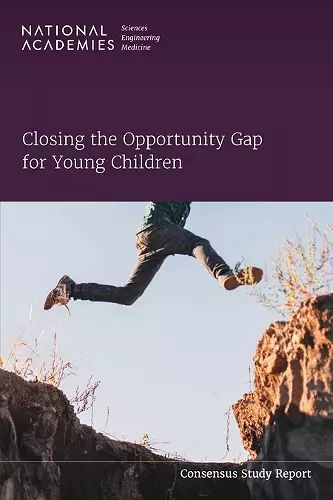Closing the Opportunity Gap for Young Children
Division of Behavioral and Social Sciences and Education author Board on Children, Youth, and Families author National Academies of Sciences, Engineering, and Medicine author Committee on Exploring the Opportunity Gap for Young Children from Birth to Age Eight author Rebekah Hutton editor LaRue Allen editor
Format:Paperback
Publisher:National Academies Press
Published:2nd Nov '23
Should be back in stock very soon

Many young children in the United States are thriving and have access to the conditions and resources they need to grow up healthy. However, a substantial number of young children face more challenging conditions such as: poverty; food insecurity; exposure to violence; and inadequate access to health care, well-funded quality schools, and mental health care. In many cases, the historical origins of unequal access to crucial supports for children's physical, emotional, and cognitive development are rooted in policies that intentionally segregated and limited various populations' access to resources and create opportunity gaps that intertwine and compound to affect academic, health, and economic outcomes over an individual's life course and across generations.
Closing the Opportunity Gap for Young Children, identifies and describes the causes, costs, and effects of the opportunity gap in young children and explores how disparities in access to quality educational experiences, health care, and positive developmental experiences from birth through age eight intersect with key academic, health, and economic outcomes. The report identifies drivers of these gaps in three key domains—education, mental health, and physical health—and offers recommendations for policy makers for addressing these gaps so that all children in the United States have the opportunity to thrive. In addition, the report offers a detailed set of recommendations for policy makers, practitioners, community organizations, and philanthropic organizations to reduce opportunity gaps in education, health, and social-emotional development.
Table of Contents- Front Matter
- Summary
- 1 Introduction
- 2 Opportunity Gaps in Early Care and Education Experienced by Children from Birth to Pre-K
- 3 Opportunity Gaps in the Education Experienced by Children in Grades K3
- 4 Opportunity Gaps in the Physical Health and Health Care Experienced by Young Children and Their Parents
- 5 Opportunity Gaps in the Social-Emotional Development, Well-being, and Mental Health Experienced by Young Children
- 6 The Economic Costs of the Opportunity Gap
- 7 Research, Policy, and Practice: Contexts and Efforts to Address Opportunity Gaps
- 8 Key Conclusions and Recommendations
- Appendix A: A Total Population of Children Ages 08 by Race/Ethnicity and Nativity, 2020
- Appendix B: Percentage of Children from Birth through Age 5 and Not Yet in Kindergarten Participating in Various Weekly Nonparental Care Arrangements, by Child and Family Characteristics, 2019
- Appendix C: Committee Member and Staff Biosketches <
ISBN: 9780309694612
Dimensions: unknown
Weight: unknown
452 pages